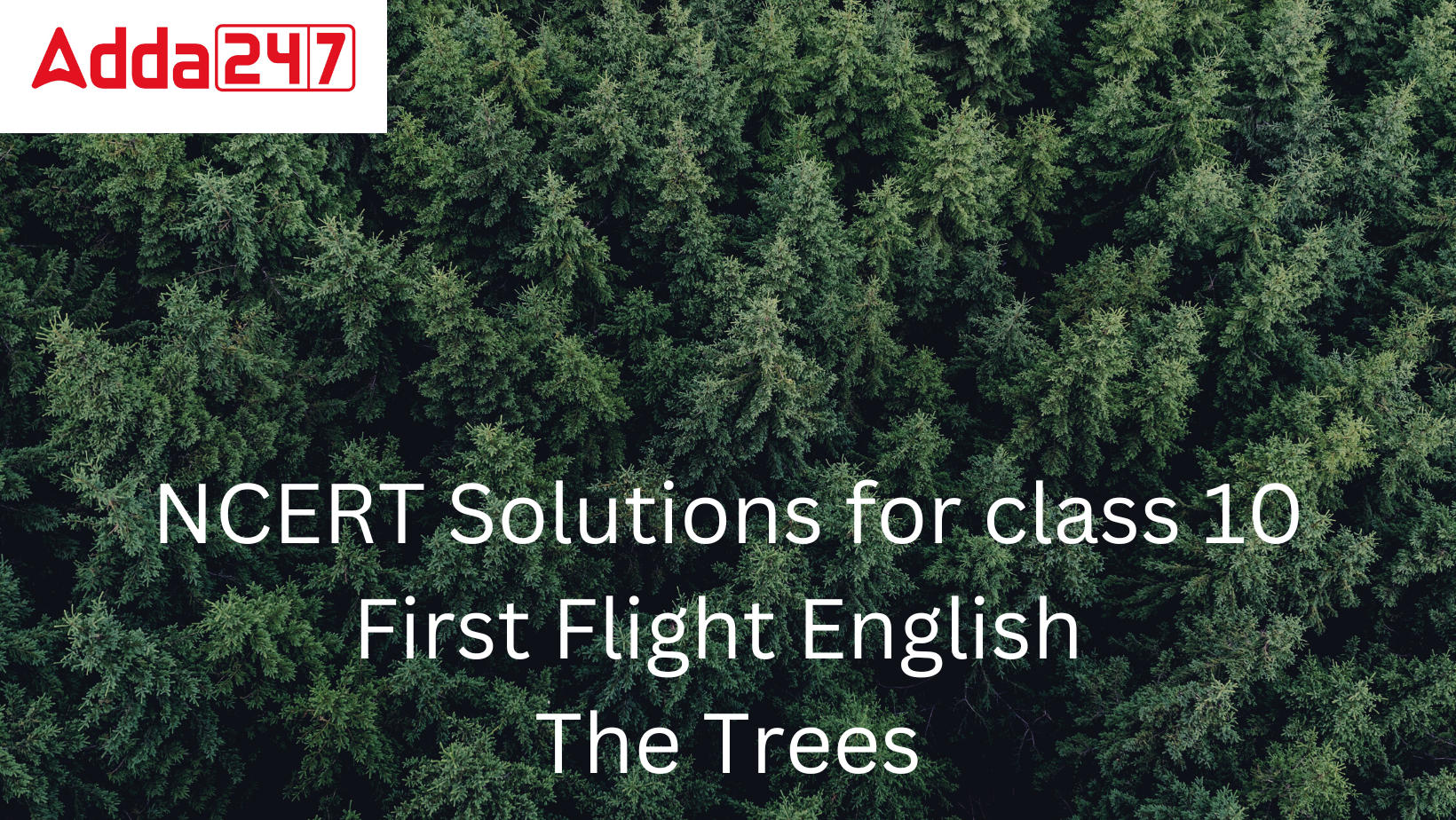Table of Contents
NCERT Solutions Class 10 English First Flight Poetry Chapter 7 The Trees
This poem is about the ornamental flora. For aesthetic purposes, these plants are grown inside of homes. These develop in little pans and pots. They have replaced large forest trees that humans cut down. This poem paints a picture of the damage humans have inflicted on the environment. The poem “The Trees” by Adrienne Rich is a voice with a body engaged in activities and experiencing intrusions outside the rules of nature poetry. This poem describes a group of trees trying to break free from a natural enclosure, such as a greenhouse. The poet describes how trees long to be freed from the shackles of man-made objects and returned to their natural habitat.
NCERT Solutions For Class 10 English First Flight Poetry Chapter 7 The Trees: Video Explanation
Watch the given video explanation for a better understanding of the chapter
NCERT Solutions For Class 10 English First Flight Poetry Chapter 7 The Trees: PDF
A PDF is given below for the students’ accessibility which they can download for future reference
NCERT Solutions For Class 10 English First Flight Poetry Chapter The Trees
NCERT Solutions For Class 10 English First Flight Poetry Chapter 7 The Trees: Solved Textbook Questions
Question 1: (i) Find, in the first stanza, three things that cannot happen in a treeless forest.
(ii) What picture do these words create in your mind: “… sun bury its feet in shadow…”? What could the poet mean by the sun’s ‘feet’?
Answer: (i) The three things that cannot happen in a treeless forest are listed below:
- the sitting of a bird on trees
- the hiding of insects in the trees
- the sun burying its feet in the shadow of the forest
(ii) The heat and sun rays that hit the earth are referred to as the sun’s “feet.” There won’t be any shade because there are no trees, therefore the sun’s rays will directly hit the earth. In contrast, the sun’s rays are obscured by the shadow in a forest of trees, giving the impression that the sun is burying its feet there.
Question 2: (i) Where are the trees in the poem? What do their roots, their leaves, and their twigs do?
(ii) What does the poet compare their branches to?
Answer: (i) The poet’s home is the only place where trees can grow in the poem. All through the night, their roots toil to free themselves from the crevices in the veranda floor. The little twigs become rigid and tight from exertion, while the leaves try to advance towards the glass and provide pressure to break it.
(ii) The poet compares the “long-cramped” branches that are shuffling beneath the roof to recently discharged hospital patients who appear half-disoriented and bewildered as they make their way towards the clinic doors. Because they want to be freed so they can stretch out completely in the open air outside, the huge branches of the trees become confined under the roof.
Question 3: (i) How does the poet describe the moon: (a) at the beginning of the third stanza, and (b) at its end? What causes this change?
(ii) What happens to the house when the trees move out of it?
(iii) Why do you think the poet does not mention “the departure of the forest from the house” in her letters? (Could it be that we are often silent about essential happenings that are so unexpected that they embarrass us? Think about this again when you answer the next set of questions.)
Answer: (i) The poet notes that the full moon is gleaming in the clear night sky at the start of the third line. The moon beams on the tops of the tallest oak trees, she writes toward the conclusion of the verse, breaking into countless fragments like a fractured mirror. From her house, the trees move outside, blocking some of the moonlight, which is only partially visible. This supports the poet’s claim that the moon has fragmented.
(ii) Glass shattering and a voice-like scent of lichen and leaves fill the rooms of the house as the trees leave.
(iii) Because people don’t value nature in the first place, the poet seldom ever refers to “the departure of the forest from the house” in her letters. She therefore believes that no one would be interested in learning how difficult the trees are working to liberate themselves. She also says that if people had truly cared for the trees, they would have never considered destroying them. We may therefore comprehend the poet’s joy at realising that the woodland was once again filled with the full beauty of the trees.
Question 4: Now that you have read the poem in detail, we can begin to ask what the poem might mean. Here are two suggestions. Can you think of others?
(i) Does the poem present a conflict between man and nature? Compare it with A Tiger in the Zoo. Is the poet suggesting that plants and trees, used for ‘interior decoration’ in cities while forests are cut down, are ‘imprisoned’, and need to ‘break out’?
(ii) On the other hand, Adrienne Rich has been known to use trees as a metaphor for human beings; this is a recurrent image in her poetry. What new meanings emerge from the poem if you take its trees to be symbolic of this particular meaning?
Answer: The poem may connote different meanings to different readers. The poet tries to explain two different things using the same metaphors in the poem.
(i) Yes, there is a clash between man and nature in the poem. Nature has always been vulnerable to human abuse, often without our being aware of the value and advantages it provides. They engage in widespread deforestation, which upsets the ecological balance and destroys the beauty of the surrounding landscape. In order to deny them their natural freedom, man seeks to restrict plants and trees in constrained areas. The branches of the trees are drawn to stretch out and take in the outside air as a result. Similar to this, the poet demonstrates in the poem “A Tiger in the Zoo” how animals locked in cages are unable to enjoy their independence since even they yearn to be released and allowed to go around freely in the open space.
(ii) It may be argued that if trees have served as a metaphor for people, then people, like trees, would wish to escape the constraints of their hectic schedules and the constricting restrictions that life places on them. Men work very hard every day to get a living, but they aren’t always able to take advantage of its advantages. Although modern life offers a great deal of physical comfort, it also has some disadvantages. Therefore, much like the trees, man yearns to escape from all of his responsibilities and take in the tranquilly of nature in its natural setting.
Question 5: You may read the poem ‘On Killing a Tree by Gieve Patel (Beehive – Textbook in English for Class IX, NCERT). Compare and contrast it with the poem you have just read.
Answer: Students have to do it themselves.
|
Found this article helpful? Let’s connect via chat or call our senior expert counselor at +91-9625869989 to learn more about the different streams and options available. We would love it if we could add some of your insights. If you have a definite goal of scoring the highest marks, then you can resolve your doubts via our Adda247 app/quizzes and youtube class assistance (https://www.youtube.com/c/Adda247School) |
NCERT Solutions For Class 10 English First Flight Poetry Chapter 7 The Trees: FAQs
Que. Where and how to download NCERT Solutions for Class 10 English?
Ans. The NCERT Solutions for Class 10 English are available for easy download at Adda247’s website. The textbook questions present in the NCERT textbook of Class 10 English are solved in a detailed manner by our team of subject experts, according to the NCERT guidelines. The download links are provided under each chapter’s web pages.
Que. What are the benefits of using the NCERT Solutions for Class 10 English First Flight from Adda247?
Ans. The benefits of using the NCERT Solutions for Class 10 English First Flight from Adda247 are:
- Along with NCERT Solution, the student is getting video explanations also.
- PDF is also provided that can be downloaded and saved for future reference.
Que. How do the NCERT Solutions for Class 10 English First Flight help you to score efficiently?
Ans. The NCERT Solutions for Class 10 English are prepared in a CBSE-specific format to score good marks in the board exam. The solutions created are 100% accurate as per the exam pattern and marks weightage designed by the prescribed board. By using the NCERT Solutions from ADDA 247, students will be able to understand the concepts effectively and score well in the board exams. Students can download the solutions and answer the textbook questions without any difficulty. It also helps students to get their doubts cleared immediately.



 CUET Physics Chapter Wise Weightage 2025...
CUET Physics Chapter Wise Weightage 2025...
 West Bengal HS Result 2025, WBCHSE Class...
West Bengal HS Result 2025, WBCHSE Class...
 UK, UP, MP, CBSE Board Result 2025 Live ...
UK, UP, MP, CBSE Board Result 2025 Live ...










